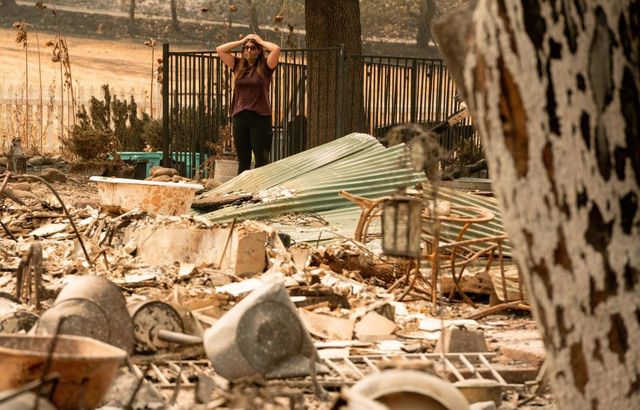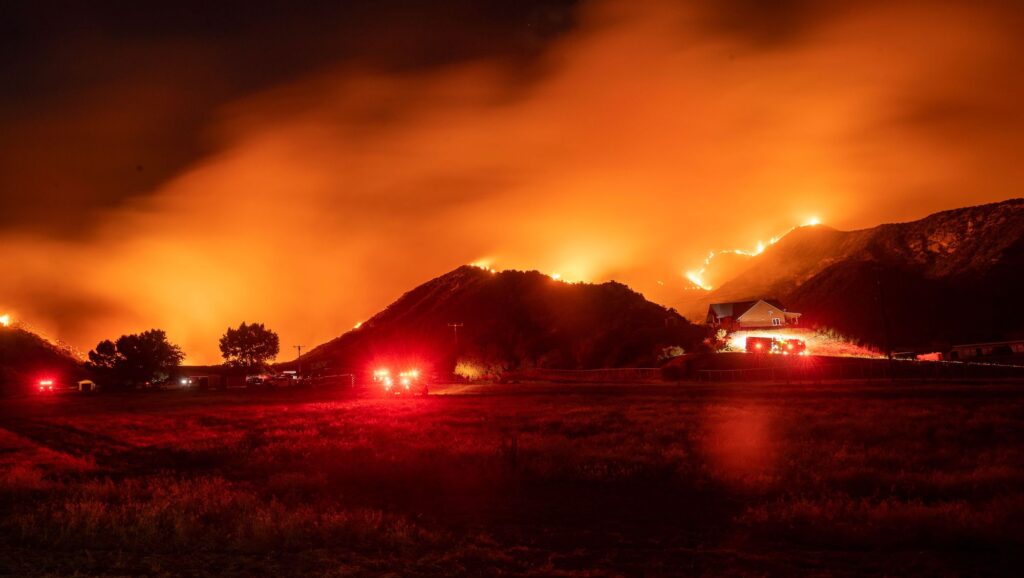
Josh Edelson/AFP via Getty Images
Late summer is prime time for both wildfires in the West and the hurricanes that menace the Gulf of Mexico. But this year’s massive wildfires in Northern California, and a feared double whammy of storms in Texas and Louisiana, arrive in the midst of a historic pandemic that has transformed everyday life in the U.S. and will complicate the recovery.
“I’ve never seen anything like this,” says Randall Bell, CEO of Landmark Research Group, which analyzes real estate after cataclysmic events. “We’re always busy [with natural disasters]. This is just overload. The country’s psyche is already beat up by everything, and it just keeps piling on.”
The confluence of two potential clusters of major disasters, at a time when the nation’s economy is reeling from a coronavirus-fueled recession, means that the typical resources for recovery, from housing to insurance adjusters to people’s personal finances, will be spread thin. The pandemic itself adds another level of health risk to every interaction, and more delays at every step. And the displacement of tens of thousands of people and potential wide-scale damage to housing are likely to exacerbate a long-running housing shortage and affordability problem, especially in California.
More than a million acres have been consumed by wildfires in California, after a series of freak lightning storms. The largest of the nine major fires, according to the California Department of Forestry and Fire Protection, is the SCU Lightning Complex, a group of fires just east of Silicon Valley that have consumed almost 364,000 acres and destroyed 18 structures. It just recently outstripped the LNU Lightning Complex in Napa and Sonoma counties, north of San Francisco, which has killed five people, burned through almost 353,000 acres, and destroyed more than 930 structures.
Although not many residences have been affected so far, roughly 17,125 homes with an estimated value of $11.8 billion were at risk as of Tuesday afternoon, according to the most recent realtor.com® analysis.
Meanwhile, Tropical Storm Marco fizzled into a tropical depression shortly after making landfall in southern Louisiana on Monday, but there was no time for a sigh of relief. The area is still braced against Hurricane Laura, expected to hit the coasts of Texas and Louisiana on Wednesday night or Thursday morning as a Category 3 storm with maximum sustained winds of 115 mph, according to the National Hurricane Center.
Nearly 432,000 homes could be affected, with a reconstruction cost value of $88.63 billion, according to a recent analysis from real estate data firm CoreLogic. More than a half-million people were ordered to evacuate the coast in advance of Laura’s arrival. And if they return to damaged or destroyed homes, they’ll have a long road ahead of them.
“Rebuilding, a big task in the best of times, is going to be uniquely challenging in a pandemic,” says realtor.com Chief Economist Danielle Hale.
Evacuations are fraught and temporary housing is scarce

Joe Raedle/Getty Images
As these natural disasters displace tens of thousands of people, problems with both short- and longer-term housing are already looming. Whether evacuees stay with friends and family or in temporary shelters, there will be an increased risk of transmitting the coronavirus at a time when people are supposed to be staying 6 feet apart. For elderly and immunocompromised people, that’s a significant danger.
“If you have to evacuate a lot of people, it’s mixing [people] and having people traveling long distances,” says Chuck Watson, director of research and development at Enki Holdings. The Savannah, GA–based data and analytics firm looks at economic impacts from natural and human-made disasters.
There’s a financial toll, as well. Many of those who stay in hotels and short-term rentals will be paying those expenses out of pocket at a time when many families are grappling with unemployment, loss of income, and financial insecurity indirectly caused by the pandemic.
Those whose homes are rendered uninhabitable will have to seek temporary rentals, pushing up prices on whatever housing remains. Displaced renters will find themselves competing with one another as well as with homeowners, who often have larger budgets, for a slim supply of rental properties.
“There’s just not a lot of spare housing, whether you’re looking at homes that are for sale or for rent nationwide,” says Hale. “That’s going to make it more difficult for displaced families looking for temporary housing.”
In the longer term, the loss of these homes and rental units in the affected regions will likely exacerbate the housing shortage and affordability problem.
“Demand for undamaged homes goes up” after a disaster, says appraiser Bell.
Prices for rentals and for-sale properties in nearby areas that were spared can rise 10% to 20% “easily,” he says. “People are desperate. They want to stay in their communities.”
Recovery amid a coronavirus-fueled recession could be slow

Scott Dalton/Bloomberg via Getty Images
Homes might already be less prepared for disaster this year than they would have been in a stronger economy. Blame the bite the recession took out of many folks’ budgets. Out-of-work homeowners are likely to put off maintenance like repairing leaky roofs or trimming flammable brush, or skip preventive measures like buying sandbags to prevent flooding.
“People don’t have as much money to spend on mitigating the effects of natural disasters,” says John Rollins, who specializes in catastrophe-exposed properties as a principal at Milliman, an actuarial and consulting firm.
The pandemic, meanwhile, could lead to delays in insurance claim payouts, which in turn would delay reconstruction efforts. Insurance adjusters must travel to these damaged and destroyed properties to assess the damage, at a time when travel is seen as a high-risk activity. In addition, having two clusters of disasters in different parts of the country at roughly the same time means there are fewer of these insurance specialists to go around.
In addition, the calamities will likely lead to higher insurance premiums down the line. Insurance companies paying out wildfire claims on one coast and storm damage in another part of the country will incur substantial costs, says Rollins. Those costs are typically passed down to consumers when they renew their policies.
It also can take years for communities to recover from a major catastrophe.

Josh Edelson/AFP via Getty Images
California is still rebuilding from wildfires that blazed through the state over the past few years. The town of Paradise, which was devastated by the Camp Fire, is still rebuilding two years later, says appraiser Bell. A worst-case scenario is New Orleans’ experience after Hurricane Katrina in 2005. It took the city about a decade to recover, although some would argue that it still hasn’t finished.
The confluence of several disasters is also likely to drive up prices for construction workers and building materials—at a time when many folks can least afford those inflated costs.
After large-scale catastrophes, regional prices for materials such as lumber and drywall are usually higher for three to six months, says Robert Dietz, chief economist of the National Association of Home Builders. This can slow down home reconstruction.
This year, lumber prices were up more than 125% since mid-April, even before the disasters. That’s because of the pandemic and the resulting flurry of homeowners remodeling their homes and builders rushing to put up new construction projects to meet fresh demand. The cost of some other materials has more than tripled.
“There are already material availability concerns for the industry,” says Dietz. “Increased demand from disaster repair would make this situation worse, and harm housing affordability.”
The post As Hurricane and Wildfires Threaten Homes, Coronavirus Complicates a Recovery appeared first on Real Estate News & Insights | realtor.com®.
